
The return of victorious Soviet soldiers at a railway station in Moscow in 1945.
At the end of the war, millions of people were dead and millions homeless, the European economy had collapsed, and much of the European industrial infrastructure had been destroyed.
The Soviet Union, too, had been heavily affected. Borders were redrawn and homecomings, expulsions, and burials were under way. But the massive efforts to rebuild had just begun.
Despite their wartime alliance, tensions between the Soviet Union and the United States and Great Britain Allies during World War II, the USA and the USSR became competitors on the world stage and engaged in the Cold War, so called because it never resulted in overt, declared hot war between the two powers but was instead characterized by espionage, political subversion and proxy wars.
Western Europe and Japan were rebuilt through the American Marshall Plan whereas Central and Eastern Europe fell under the Soviet sphere of influence and eventually an “Iron Curtain”. Europe was divided into a US-led Western Bloc and a Soviet-led Eastern Bloc.

German Wehrmacht General Anton Dostler is tied to a stake before his execution by a firing squad in a stockade in Aversa, Italy, on December 1, 1945. The General, Commander of the 75th Army Corps, was sentenced to death by an United States Military Commission in Rome for having ordered the shooting of 15 unarmed American prisoners of war, in La Spezia, Italy, on March 26, 1944. Read more about the story of this picture.
Internationally, alliances with the two blocs gradually shifted, with some nations trying to stay out of the Cold War through the Non-Aligned Movement.
The Cold War also saw a nuclear arms race between the two superpowers; part of the reason that the Cold War never became a “hot” war was that the Soviet Union and the United States had nuclear deterrents against each other, leading to a mutually assured destruction standoff.
As a consequence of the war, the Allies created the United Nations, an organization for international cooperation and diplomacy, similar to the League of Nations. Members of the United Nations agreed to outlaw wars of aggression in an attempt to avoid a third world war.

Soviet soldiers with lowered standards of the defeated Nazi forces during the Victory Day parade in Moscow, on June 24, 1945.
The devastated great powers of Western Europe formed the European Coal and Steel Community, which later evolved into the European Common Market and ultimately into the current European Union.
This effort primarily began as an attempt to avoid another war between Germany and France by economic cooperation and integration, and a common market for important natural resources.
The end of the war also increased the rate of decolonization from the great powers with independence being granted to India (from the United Kingdom), Indonesia (from the Netherlands), the Philippines (from the US), and a number of Arab nations, primarily from specific rights which had been granted to great powers from League of Nations Mandates in the post World War I-era but often having existed de facto well before this time.
Also related to this was the US helping Israel gain controversial independence from its previous status as part of Palestine in the years immediately following the war. Independence for the nations of Sub-Saharan Africa came more slowly.
The aftermath of World War II also saw the rise of communist influence in Southeast Asia, with the People’s Republic of China, as the Chinese Communists emerged victorious from the Chinese Civil War in 1949.

Gaunt and emaciated, but happy at their release from Japanese captivity, two Allied prisoners pack their meager belongings, after being freed near Yokohama, Japan, on September 11, 1945, by men of an American mercy squadron of the U.S. Navy.

Aerial view of Hiroshima, Japan, one year after the atomic bomb blast shows some small amount of reconstruction amid much ruin on July 20, 1946. The slow pace of rebuilding is attributed to a shortage of building equipment and materials.
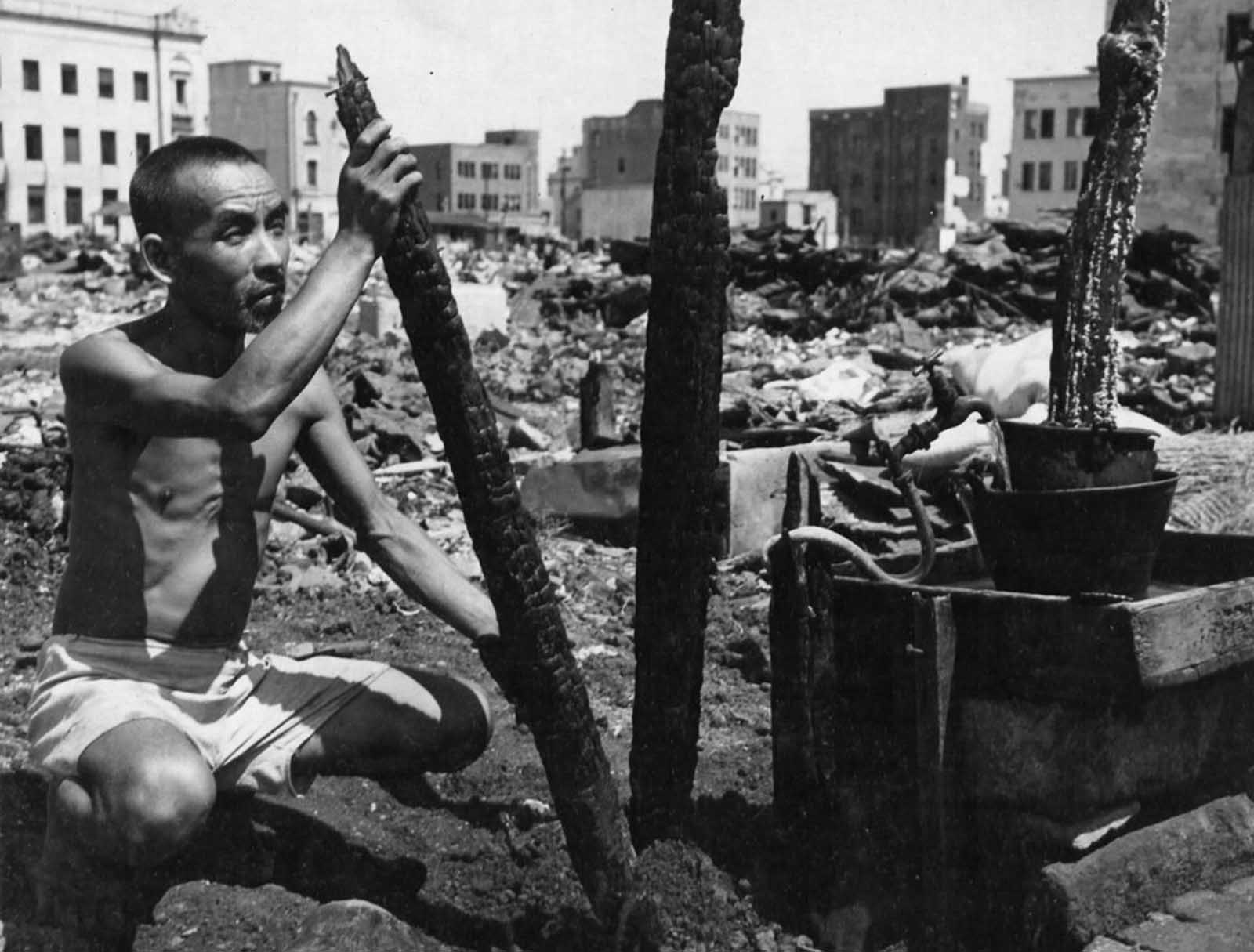
A Japanese man amid the scorched wreckage and rubble that was once his home in Yokohama, Japan.

Red Army photographer Yevgeny Khaldei (center) in Berlin with Soviet forces, near the Brandenburg Gate in May of 1945.

A P-47 Thunderbolt of the U.S. Army 12th Air Force flies low over the crumbled ruins of what once was Hitler’s retreat at Berchtesgaden, Germany, on May 26, 1945. Small and large bomb craters dot the grounds around the wreckage.

Hermann Goering, once the leader of the formidable Luftwaffe and second in command of the German Reich under Hitler, appears in a mugshot on file with the Central Registry of War Criminals and Security Suspects in Paris, France, on November 5, 1945. Goering surrendered to U.S. soldiers in Bavaria, on May 9, 1945, and was eventually taken to Nuremburg to face trial for War Crimes.

The interior of the courtroom of the Nuremberg War Crimes Trials in 1946 during the Trial of the Major War Criminals, prosecuting 24 government and civilian leaders of Nazi Germany. Visible here is Hermann Goering, former leader of the Luftwaffe, seated in the box at center right, wearing a gray jacket, headphones, and dark glasses. Next to him sits Rudolf Hess, former Deputy Fuhrer of Germany, then Joachim von Ribbentrop, former Nazi Minister of Foreign Affairs, Wilhelm Keitel, former leader of Germany’s Supreme Command (blurry face), and Ernst Kaltenbrunner, the highest ranking surviving SS-leader. Goering, von Ribbentrop, Keitel, and Kaltenbrunner were sentenced to death by hanging along with 8 others — Goering committed suicide the night before the execution. Hess was sentenced to life imprisonment, which he served at Spandau Prison, Berlin, where he died in 1987.

Many of Germany’s captured new and experimental aircraft were displayed in an exhibition as part of London’s Thanksgiving week on September 14, 1945. Among the aircraft are a number of jet and rocket propelled planes. Here, a side view of the Heinkel He-162 “Volksjaeger”, propelled by a turbo-jet unit mounted above the fuselage, in Hyde park, in London.

One year after the D-Day landings in Normandy, German prisoners landscape the first U.S. cemetery at Saint-Laurent-sur-Mer, France, near “Omaha” Beach, on May 28, 1945.

Sudeten Germans make their way to the railway station in Liberec, in former Czechoslovakia, to be transferred to Germany in this July, 1946 photo. After the end of the war, millions of German nationals and ethnic Germans were forcibly expelled from both territory Germany had annexed, and formerly German lands that were transferred to Poland and the Soviet Union. The estimated numbers of Germans involved ranges from 12 to 14 million, with a further estimate of between 500,000 and 2 million dying during the expulsion.

A survivor of the first atomic bomb ever used in warfare, Jinpe Teravama retains scars after the healing of burns from the bomb explosion, in Hiroshima, in June of 1947.

Disabled buses that have littered the streets of Tokyo are used to help relieve the acute housing shortage in the Japanese capital on October 2, 1946. Homeless Japanese who hauled the buses into a vacant lot are converting them into homes for their families.

An American G.I. places his arm around a Japanese girl as they view the surroundings of Hibiya Park, near the Tokyo palace of the emperor, on January 21, 1946.
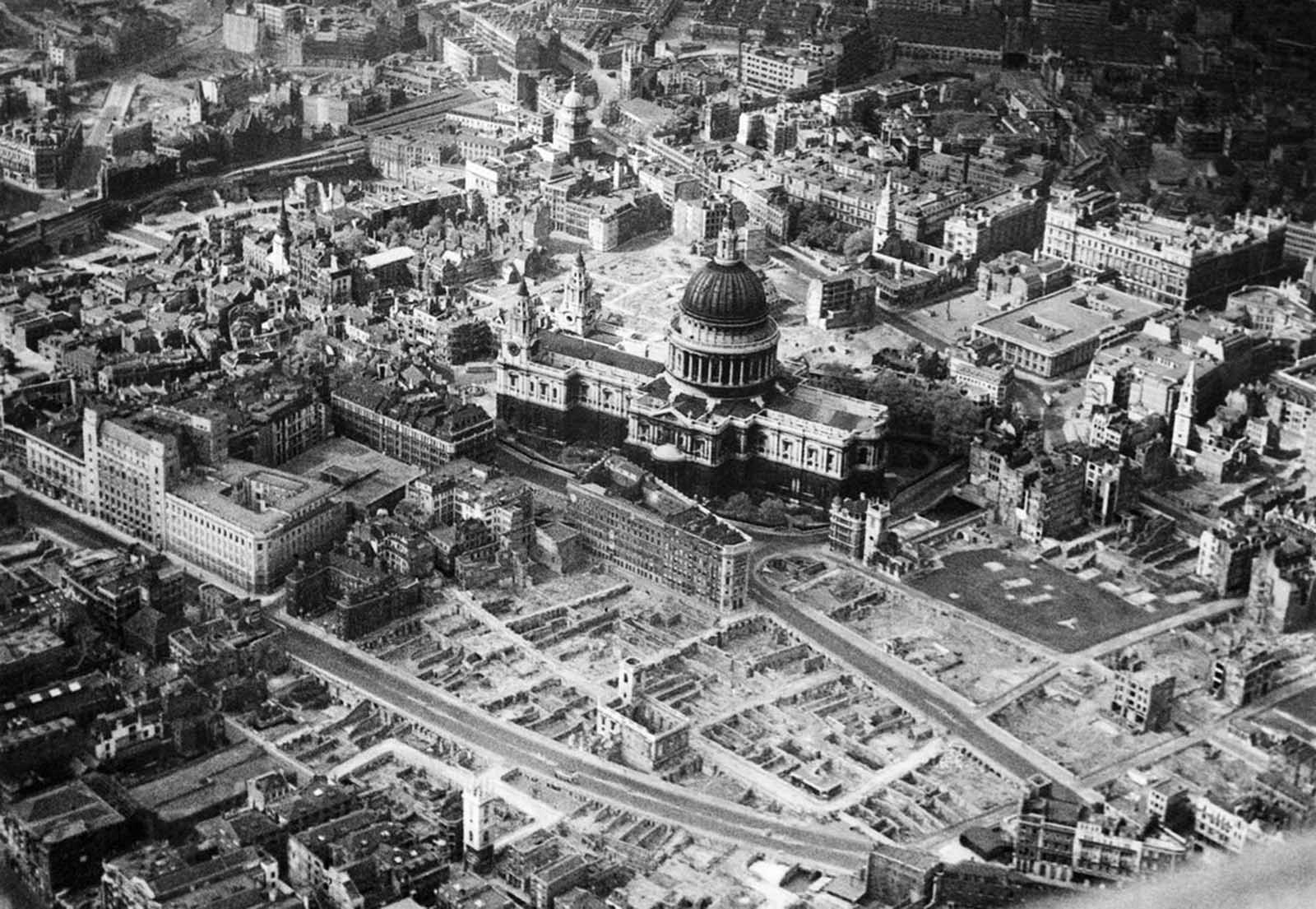
This is an aerial view of the city of London around St. Paul’s Cathedral showing bomb-damaged areas in April of 1945.

General Charles de Gaulle (center) shaking hands with children, two months after the German capitulation in Lorient, France, in July of 1945. Lorient was the location of a German U-boat (submarine) base during World War II. Between January 14 and February 17, 1943, as many as 500 high-explosive aerial bombs and more than 60,000 incendiary bombs were dropped on Lorient. The city was almost completely destroyed, with nearly 90% of the city flattened.

The super transport ship, General W.P. Richardson, docked in New York, with veterans of the European war cheering on June 7, 1945. Many soldiers were veterans of the African campaign, Salerno, Anzio, Cassino and the winter warfare in Italy’s mountains.

This aerial file photo shows a portion of Levittown, New York, in 1948 shortly after the mass-produced suburb was completed on Long Island farmland in New York. This prototypical suburban community was the first of many mass-produced housing developments that went up for soldiers coming home from World War II. It also became a symbol of postwar suburbia in the U.S.

This television set, retailing for $100, is reportedly the first moderately priced receiver manufactured in quantity. Rose Clare Leonard watches the screen, which reproduces a 5×7 image, as she tunes in at the first public post-war showing at a New York department store, on August 24, 1945. Although television was invented prior to World War II, the war prevented mass production. Soon after the war, sales and production picked up, and by 1948, regular commercial network programming had begun.

A U.S. soldier examines a solid gold statue, part of Hermann Goering’s private loot, found by the 7th U.S. Army in a mountainside cave near Schonau am Konigssee, Germany, on May 25, 1945. The secret cave, the second found to date, also contained stolen priceless paintings from all over Europe.

In Europe, some churches have been completely ruined, but others still stand amid utter devastation. Munchengladbach Cathedral stands here in the rubble, though still in need of repairs, seen in Germany, on November 20, 1945.

On May 21, Colonel Bird, Commandant of Belsen Camp, gave the order for the last hut at Belsen Concentration Camp to be burned. A rifle salute was fired in honor of the dead, the British flag was run up at the same moment as a flame-thrower set fire to the last hut. A German flag and portrait of Hitler went up in flames inside the hut in June of 1945.

German mothers walk their children to school through the streets of Aachen, Germany, on June 6, 1945, for registration at the first public school to be opened by the U.S. military government after the war.

A general view of the International Military Tribunal for the Far East meeting in Tokyo in April, 1947. On May 3, 1946, the Allies began the trial of 28 Japanese civilian and military leaders for war crimes. Seven were hanged and others were sentenced to prison terms.

Soviet soldiers on the march in northern Korea in October of 1945. Japan had ruled the Korean peninsula for 35 years, until the end of World War II. At that time, Allied leaders decided to temporarily occupy the country until elections could be held and a government established. Soviet forces occupied the north, while U.S. forces occupied the south. The planned elections did not take place, as the Soviet Union established a communist state in North Korea, and the U.S. set up a pro-western state in South Korea – each state claiming to be sovereign over the entire peninsula. This standoff led to the Korean War in 1950, which ended in 1953 with the signing of an armistice — but, to this day, the two countries are still technically at war with each other.
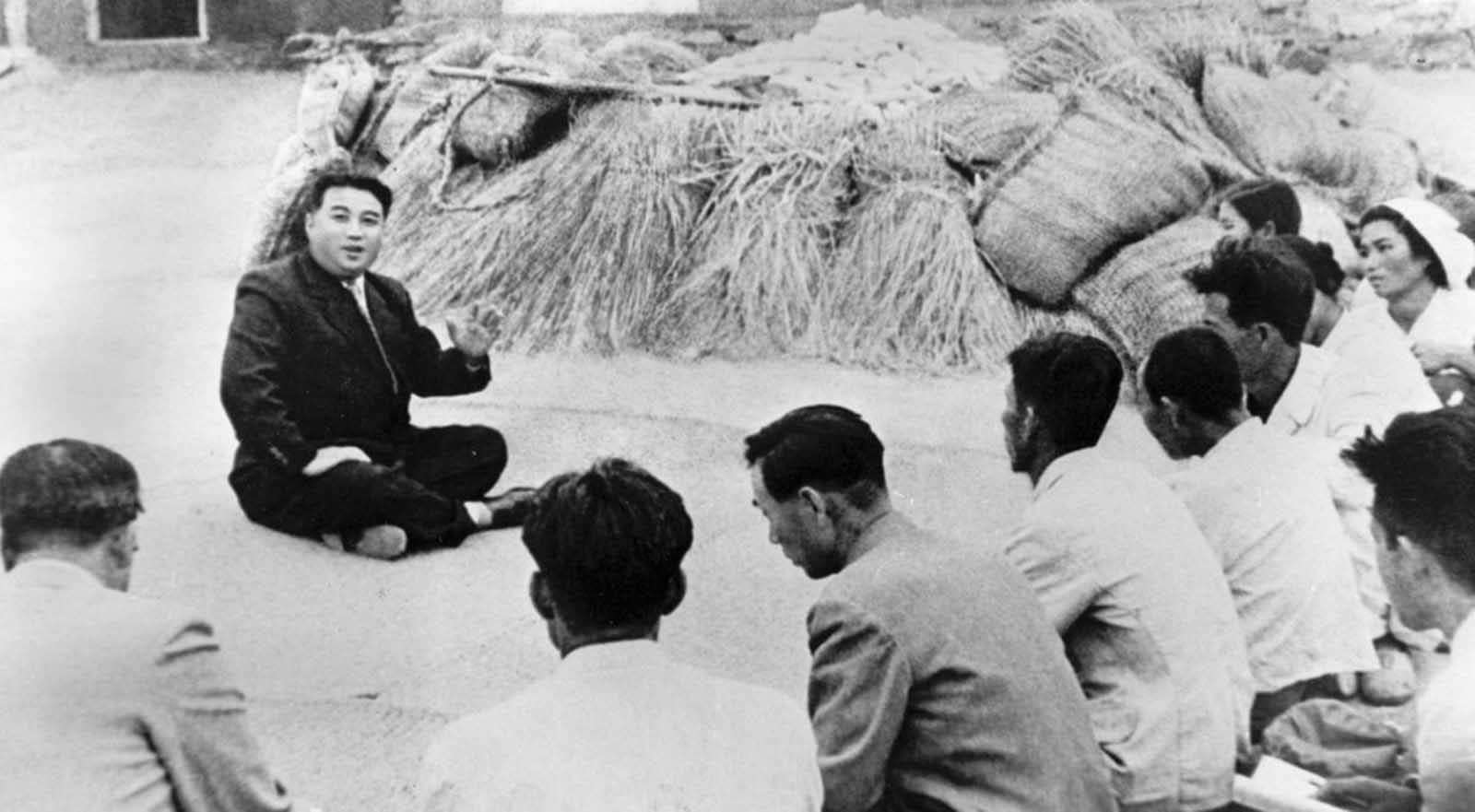
In this October 1945 photo from North Korea’s official Korean Central News Agency, communist leader Kim Il Sung chats with a farmer from Qingshanli, Kangso County, South Pyongyang in North Korea.

Soldiers of the Chinese communist Eighth Route Army on the drill field at Yanan, capital of a huge area in North China which is governed by the Chinese Communist Party, seen on March 26, 1946. These soldiers are members of the “Night Tiger” battalion. The Chinese Communist Party (CPC) had waged war against the ruling Kuomintang (KMT or Chinese Nationalist Party) since 1927, vying for control of China. Japanese invasions during World War II forced the two sides to put most of their struggles aside to fight a common foreign foe — though they did still fight each other from time to time. After World War II ended, and the Soviet Union pulled out of Manchuria, full scale civil war erupted in China in June of 1946. The KMT eventually was defeated, with millions retreating to Taiwan, as CPC leader Mao Zedong established the People’s Republic of China in 1949.

This 1946 photograph shows ENIAC (Electronic Numerical Integrator And Computer), the first general purpose electronic computer – a 30-ton machine housed at the University of Pennsylvania. Developed in secret starting in 1943, ENIAC was designed to calculate artillery firing tables for the United States Army’s Ballistic Research Laboratory. The completed machine was announced to the public on February 14, 1946. The inventors of ENIAC promoted the spread of the new technologies through a series of influential lectures on the construction of electronic digital computers at the University of Pennsylvania in 1946, known as the Moore School Lectures.

A test nuclear explosion codenamed “Baker”, part of Operation Crossroads, at Bikini Atoll in the Marshall Islands, on July 25, 1946. The 40 kiloton atomic bomb was detonated by the U.S. at a depth of 27 meters below the ocean surface, 3.5 miles from the atoll. The purpose of the tests was to study the effects of nuclear explosions on ships. 73 ships were gathered to the spot — both obsolete American and captured ships, including the Japanese battleship “Nagato”. Read more about this picture.

Northrop’s Flying Wing Bomber known as the XB-35 in flight in 1946. The XB-35 was an experimental heavy bomber developed for the U.S. Army Air Force during World War II. The project was terminated shortly after the war, due to its technical difficulties.

Japanese ammunition being dumped into the sea on September 21, 1945. During the U.S. occupation, almost all of the Japanese war industry and existing armament was dismantled.
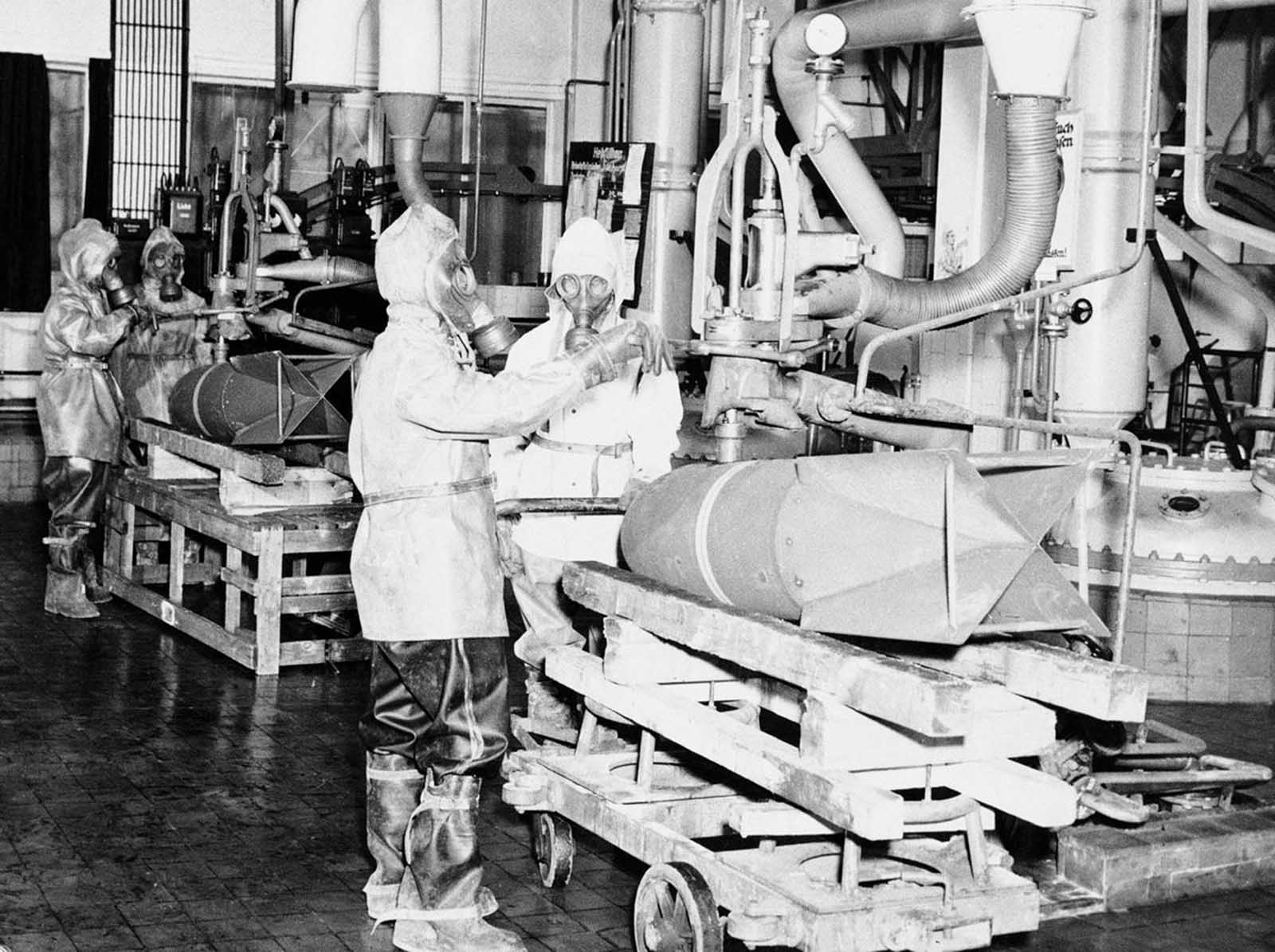
These unidentified German workers in Decontamination clothing destroy toxic bombs on June 28, 1946, at the U.S. Army Chemical Warfare Service Depot, at St. Georgen, Germany. The destruction and disposal of 65,000 dead weight tons of German toxics, including mustard gas, was accomplished in one of two ways: Burning or dumping the empty shells and bombs into the North Sea.

U.S. military authorities prepare to hang Dr. Klaus Karl Schilling, 74, at Landsberg, Germany, on May 28, 1946. In a Dachau war crimes trial he was convicted of using 1,200 concentration camp prisoners for malaria experimentation. Thirty died directly from the inoculations and 300 to 400 died later from complications of the disease. His experiments, all with unwilling subjects, began in 1942.
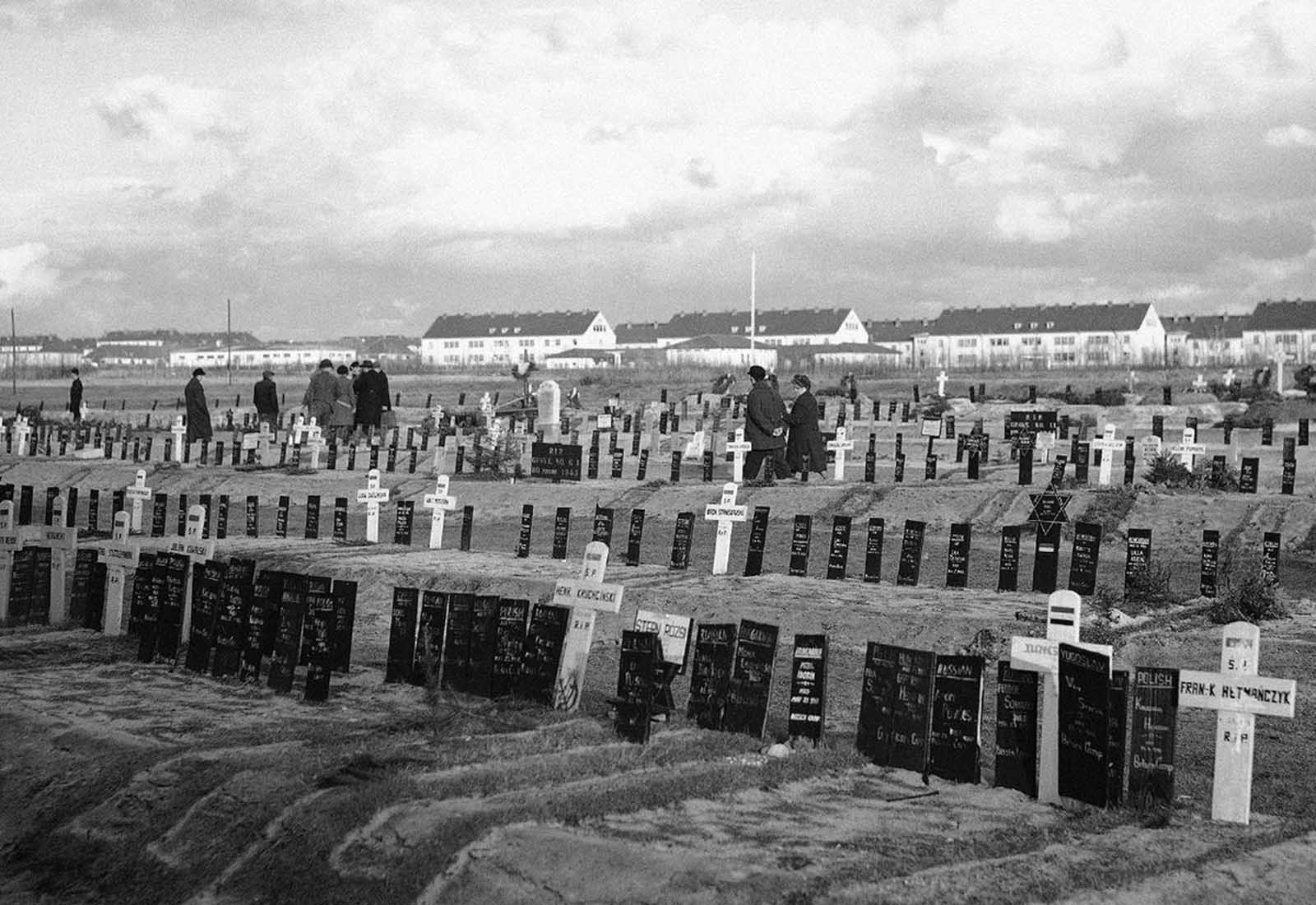
The new cemetery at Belsen, Germany on March 28, 1946, where 13,000 people who died after Belsen Concentration Camp was liberated are buried.

Jewish survivors of the Buchenwald Nazi concentration camp, some still in their camp clothing, stand on the deck of the refugee immigration ship Mataroa, on July 15, 1945 at Haifa port, during the British Mandate of Palestine, in what would later become the State of Israel. During World War II, millions of Jews were fleeing Germany and its occupied territories, many attempting to enter the British Mandate of Palestine, despite tight restrictions on Jewish immigration established by the British in 1939. Many of these would-be immigrants were caught and rounded up into detention camps. In 1947, Britain announced plans to withdraw from the territory, and the United Nations approved the Partition Plan for Palestine, establishing a Jewish and a Palestinian state in the country. On May 14, 1948, Israel declared independence and was immediately attacked by neighboring Arab states, beginning the Arab-Israeli conflict which continues to this day.
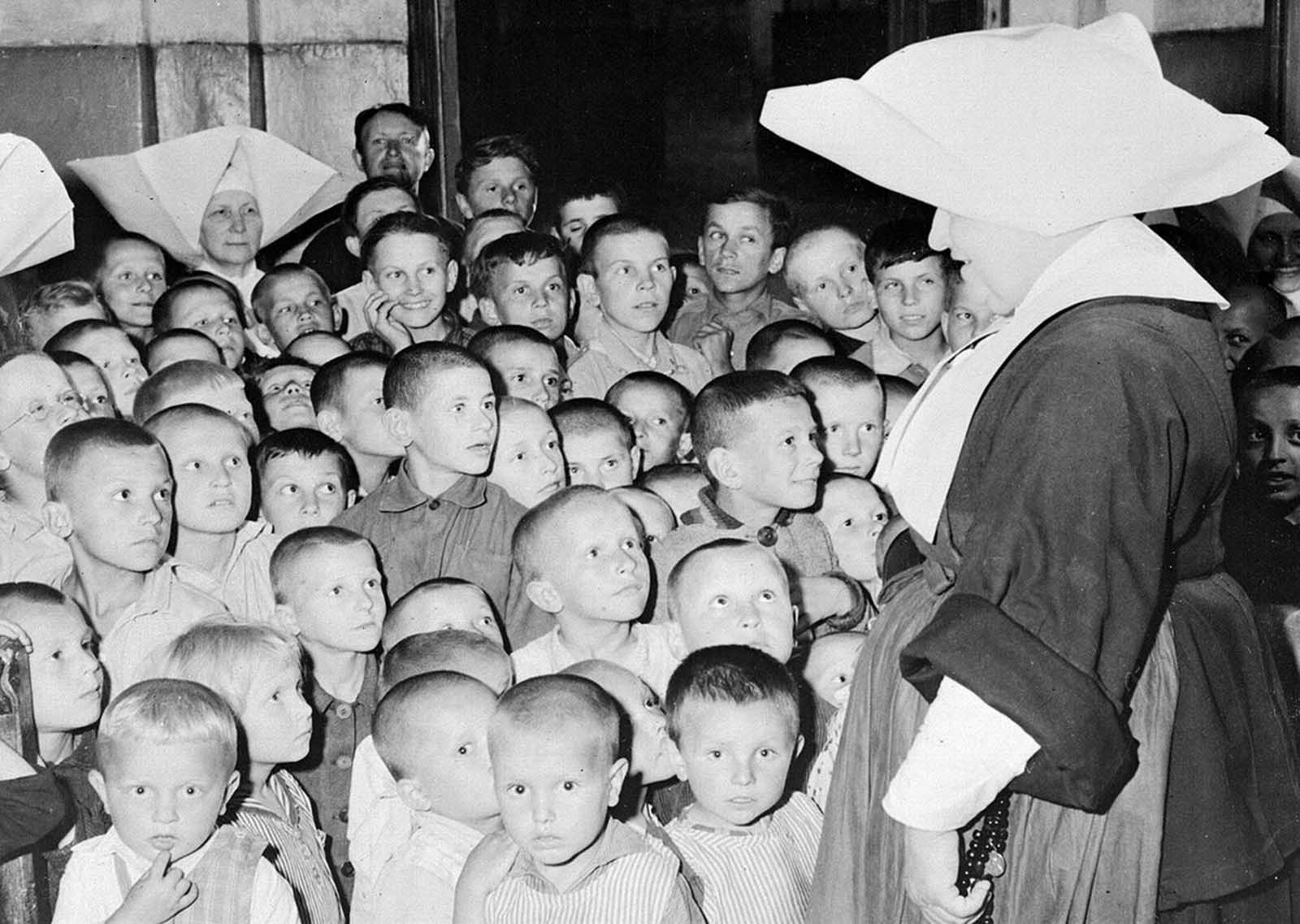
Some of Poland’s thousands of war orphans at the Catholic Orphanage in Lublin, on September 11, 1946, where they are being cared for by the Polish Red Cross. Most of the clothing, as well as vitamins and medicines, are provided by the American Red Cross.

The Empress of Japan visits a Catholic Orphanage staffed by Japanese Nuns for children who have lost their parents in the war and air raids over Tokyo. The Empress inspected the grounds and paid a visit to the chapel. Children wave Japanese flags to greet the Empress during her visit in Fujisawa in Tokyo, on April 13, 1946.

New buildings (right) rise out of the ruins of Hiroshima, Japan, on March 11, 1946. These single story homes built along a hard-surfaced highway are part of the program by the Japanese government to rebuild devastated sections of the country. At left background are damaged buildings whose masonry withstood the effects of the first atomic bomb ever detonated as a weapon.

Clocks are being readied for export to Allied countries, shown as collateral for imported goods needed by Japan. Thirty-four Japanese factories produced 123,000 clocks during April of 1946. Photo taken on June 25, 1946.

U.S. General George S. Patton acknowledges the cheers of thousands during a parade through downtown Los Angeles, California, on June 9, 1945. Shortly thereafter, Patton returned to Germany and controversy, as he advocated the employment of ex-Nazis in administrative positions in Bavaria; he was relieved of command of the 3rd Army and died of injuries from a traffic accident in December, after his return home. Joe Rosenthal’s famous Iwo Jima flag-raising photograph is visible on the war bonds billboard.

This 1945 photo shows German women clearing up the debris on Berlin’s Tauentzienstrasse, with the ruins of the Kaiser Wilhelm Church in the background. The absence of able bodied men meant that the responsibility for clearing the wreckage fell mainly to civilian women, which were called “Truemmerfrauen,” or rubble ladies. The signs on the left mark the border between the British-occupied sector and the U.S. sector of the city.

The scene in Berlin’s Republic Square, before the ruined Reichstag Building, on September 9, 1948, as Anti-Communists, estimated at a quarter of a million, scream their opposition to Communism. At the time, the Soviet Union was enforcing the Berlin Blockade, blocking Allied access to the parts of Berlin under Allied control. In response, Allies began the Berlin Airlift until the Soviets lifted the blockade in 1949, and East Germany and West Germany were established. When the meeting pictured here broke up, a series of incidents between Anti-Red Germans and Soviet troops brought tension to a fever pitch as shootings took place, resulting in the deaths of two Germans.

In March of 1974, some 29 years after the official end of World War II, Hiroo Onoda, a former Japanese Army intelligence officer, walks out of the jungle of Lubang Island in the Philippines, where he was finally relieved of duty. He handed over his sword (hanging from his hip in photo), his rifle, ammunition and several hand grenades. Onoda had been sent to Lubang Island in December of 1944 to join an existing group of soldiers and hamper any enemy attacks. Allied forces overtook the island just a few months later, capturing or killing all but Onoda and three other Japanese soldiers. The four ran into the hills and began a decades-long insurgency extending well past the end of the war. Several times they found or were handed leaflets notifying them that the war had ended, but they refused to believe it. In 1950, one of the soldiers turned himself in to Philippine authorities. By 1972, Onoda’s two other compatriots were dead, killed during guerrilla activities, leaving Onoda alone. In 1974, Onoda met a Japanese college dropout, Norio Suzuki, who was traveling the world, and through their friendship, Onoda’s former commanding officer was located and flew to Lubang Island to formally relieve Onoda of duty, and bring him home to Japan. Over the years, the small group had killed some 30 Filipinos in various attacks, but Onoda ended up going free, after he received a pardon from President Ferdinand Marcos. Read more about this story.
(Photo credit: US Army Archives / National Archives / Library of Congress).
Updated on: June 29, 2022
Any factual error or typo? Let us know.



